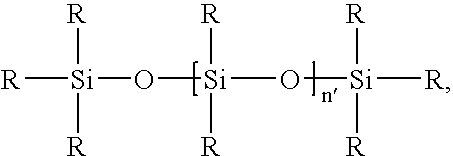Heterogeneous hydrosilylation catalysts, polymers formed therewith, and related coating compositions
a heterogeneous hydrosilylation and catalyst technology, applied in the direction of organic compounds/hydrides/coordination complexes, catalysts, physical/chemical process catalysts, etc., can solve the problems of heterogeneous catalysts being susceptible to chemical promotion or activity modification, affecting and difficult to avoid discoloration of polymers, etc., to achieve the effect of improving the color development of coating compositions
- Summary
- Abstract
- Description
- Claims
- Application Information
AI Technical Summary
Benefits of technology
Problems solved by technology
Method used
Image
Examples
example 1
[0073]In a 3000 mL glass reaction vessel 359 parts by weight of ethylene glycol monoallyl ether, 377 parts by weight of trimethylolpropane diallyl ether, 0.06 parts by weight of sodium acetate and 1 part by weight of the supported platinum catalyst of Example 4 were agitated with a stainless steel agitator under a nitrogen atmosphere. The reactor contents were heated to 90° C. From an addition funnel 410 parts by weight of 1,1,3,3-tetramethydisiloxane were fed drop-wise into the reactor over 6 hours. After complete addition the temperature was increased to 110° C. until the reaction was complete. The endpoint of the reaction was determined by infrared spectrophotometry which indicated the Si—H functionality had been consumed. The product was filtered through #1 filter paper to yield a colorless liquid with a hydroxyl number of 279 and an APHA color of 5. The material captured on the filter paper was collected, dried and weighed. The catalyst which was recovered was 90% of the origin...
example 1.1
[0074]In a 3000 mL glass reaction vessel 359 parts by weight of ethylene glycol monoallyl ether, 377 parts by weight of trimethylolpropane diallyl ether, 0.06 parts by weight of sodium acetate and 1 part by weight of the supported platinum catalyst recovered from Example 1 were agitated with a stainless steel agitator under a nitrogen atmosphere. The reactor contents were heated to 90° C. From an addition funnel 410 parts by weight of 1,1,3,3-tetramethydisiloxane were fed drop-wise into the reactor over 1 hour. After two thirds of the addition was complete the addition was stopped and the temperature was increased to 110° C. The remaining one third of the addition was made over 15 minutes at 110° C. then held at this temperature until the reaction was complete. The endpoint of the reaction was determined by infrared spectrophotometry which indicated the Si—H functionality had been consumed. The product was filtered through #1 filter paper to yield a yellow liquid.
example 1.2
[0075]In a 3000 mL glass reaction vessel 400 parts by weight of ethylene glycol monoallyl ether, 420 parts by weight of trimethylolpropane diallyl ether, 2.6 parts by weight of magnesium aluminosilicate, and 0.06 parts by weight of sodium acetate and 0.4 parts by weight of a solution of 5 parts by weight chloroplatinic acid hexahydrate in 63 parts by weight isopropanol were agitated with a stainless steel agitator under a nitrogen atmosphere. The reactor contents were heated to 90° C. From an addition funnel 457 parts by weight of 1,1,3,3-tetramethydisiloxane were fed drop-wise into the reactor over 2 hours. After complete addition the temperature was increased to 80° C. until the reaction was complete. The endpoint of the reaction was determined by infrared spectrophotometry which indicated the Si—H functionality had been consumed. The product was filtered through #2 filter paper to yield a yellow liquid. The material was returned to the glass reactor and treated with 5 parts by we...
PUM
| Property | Measurement | Unit |
|---|---|---|
| particle size | aaaaa | aaaaa |
| particle size | aaaaa | aaaaa |
| particle size | aaaaa | aaaaa |
Abstract
Description
Claims
Application Information
 Login to View More
Login to View More - R&D
- Intellectual Property
- Life Sciences
- Materials
- Tech Scout
- Unparalleled Data Quality
- Higher Quality Content
- 60% Fewer Hallucinations
Browse by: Latest US Patents, China's latest patents, Technical Efficacy Thesaurus, Application Domain, Technology Topic, Popular Technical Reports.
© 2025 PatSnap. All rights reserved.Legal|Privacy policy|Modern Slavery Act Transparency Statement|Sitemap|About US| Contact US: help@patsnap.com


